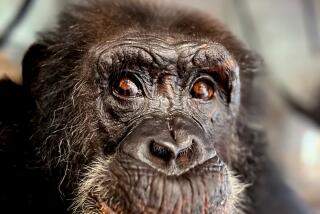Just like humans, chimpanzees warn others of impending danger

How researchers figured out that chimpanzees can evaluate danger and alert other members of their groups, particularly those that might be ignorant of that risk.
- Share via
Chimpanzees adjust their warning calls if they think a fellow primate hasn’t picked up on a nearby threat, a new study finds.
The results, published in the journal Science Advances, reveal that humans and one of their closest living relatives may share a very special ability, one that could potentially shed light on the origins of language.
Humans have succeeded as a species in large part because of our complex social communication skills — and underlying those skills is the ability to understand another individual’s perspective, and adjust what we say accordingly.
“In humans there’s a strong convention, if I’m talking to you I should generally tell you things you don’t already know,” lead author Catherine Crockford, a primatologist at Max Planck Institute for Evolutionary Anthropology in Germany, said in an email. “Right now, if I tell you things you know already, you’d probably get impatient quite quickly.”
But when an animal makes a call, does it know what its peers know or don’t know? Or is it just expressing its own internal feelings?
“There’s an assumption though, that animals don’t do this,” Crockford said. “Take alarm calls. Lots of animals give alarm calls. If a monkey gives an alarm call to a snake, it’s thought to be purely motivated by the signalers’ own perspective, like their own state of arousal, their own emotional state.”
Plenty of mammals have been spotted adjusting their calls according to context and other members’ behaviors. For example, harem male monkeys sound the alarm more when members of their group are close to a threat and only stop after those members have also called out an alarm. Studies show that chimps are more likely to alarm-call when their peers haven’t seen the threat or heard the threat-related calls, and may quiet down after those peers have made it to safety, the researchers pointed out.
The idea that an individual animal can actually understand the perspective of another individual well enough to adjust its calls accordingly is a pretty remarkable one. The problem is that in all the above examples, it’s hard to separate out whether that individual caller is simply reacting to the behaviors it observes in its peers, or truly grasps that its peers are missing a key piece of potentially life-or-death information.
To find out, Crockford and her colleagues ran a series of experiments in which they placed a fake snake made of chicken wire and plaster of Paris in the expected path of wild chimpanzees in the Budongo Forest in Uganda. In the first set of tests, the researchers video-recorded how chimps who encountered the fake snakes reacted. The chimps would make warning calls, or “alert hoos,” to a nearby chimp, and even sit by the snake as a sentinel to make the nearby chimp aware of the danger, especially if the two chimps shared a bond.
“I was most surprised that chimps seem to care so much that the other chimp actually sees the snake,” Crockford said. “Not in all cases. But especially when it’s kin or a friend. It’s not enough that the other is out of danger, has stopped approaching or starts to avoid the snake. They wait at the snake until the other actually approaches enough to see the snake.”
In the second set of tests, the scientists played audio recordings to make a wild chimpanzee think a fellow chimp was nearby but out of sight. They played one of two calls: a rest hoo, or one to three alert hoos. Then they watched to see what happened once the chimpanzee came across the fake snake.
The researchers found that if a chimpanzee heard the rest hoo audio recording, it was more likely to make an effort signaling the danger than if it had heard the alert hoo.
Here’s what this means: The chimpanzees couldn’t see any other chimp, or its reaction to their call. So they could not have been reacting to a fellow chimp’s movement or behaviors (for example, approaching or avoiding the snake). All they had to go on was a hoo or two (or three), which told them whether that unseen chimp was aware or unaware of danger. And if they thought that invisible chimp didn’t know about the snake, it seems that they tended to try harder to make that other chimp aware.
“[It] shows that there is more to animal communication than we thought, specifically that social cognition influences … vocal and nonvocal behavior,” Crockford said.
The findings could help scientists better understand the roots of language and communication in humans, she added.
“As humans, we’re inherently interested in ourselves, and one of the big puzzles is how did we come to have language?” Crockford said. “There are big debates about whether our language has roots in other animal communication or not. It seems the more we dig, the more it seems that our language capacities share continuity with animals.”
Follow @aminawrite on Twitter for more science news and “like” Los Angeles Times Science & Health on Facebook.
MORE IN SCIENCE
In Texas, odds of Hurricane Harvey rainfall could rise to nearly 1 in 5 per year by 2100
New guidelines classify nearly half of U.S. adults as having high blood pressure
This supernova was supposed to die — until it got brighter







